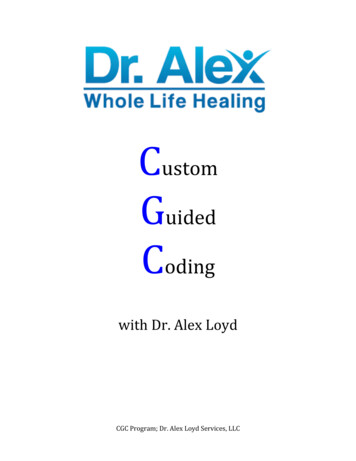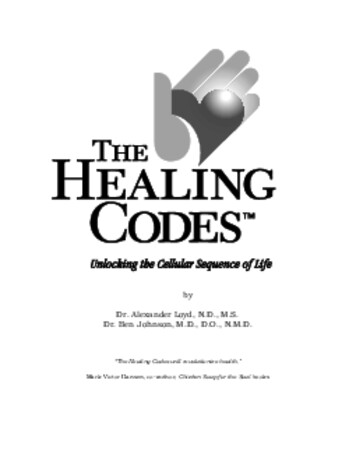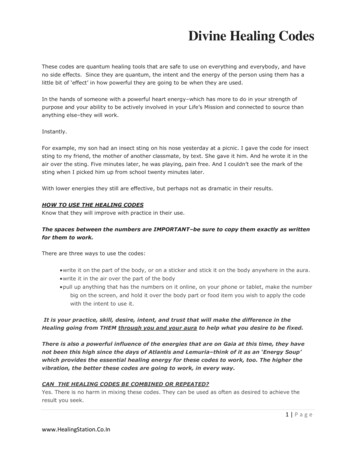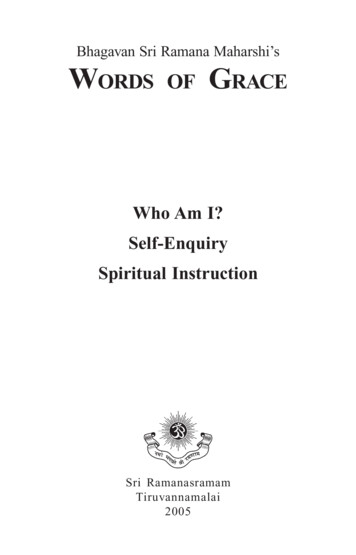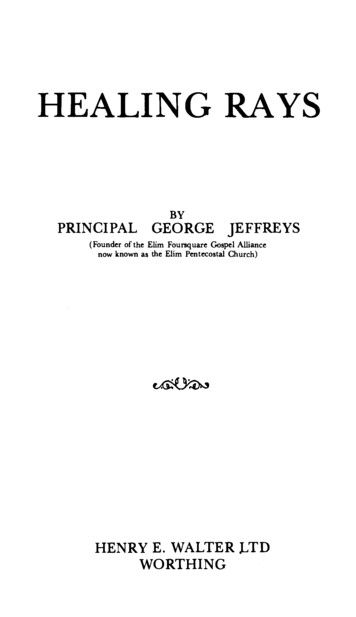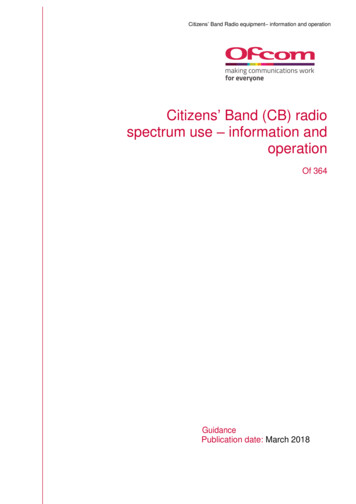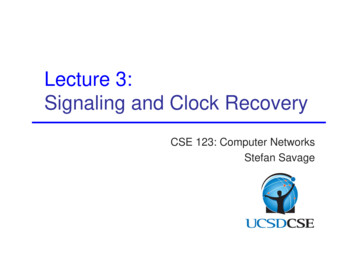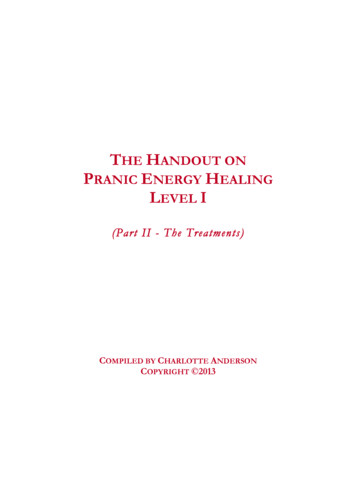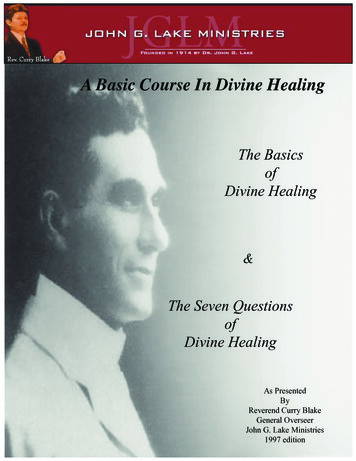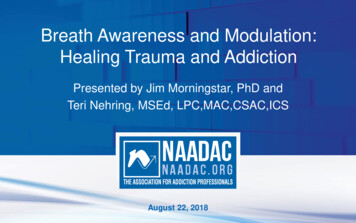
Transcription
Breath Awareness and Modulation:Healing Trauma and AddictionPresented by Jim Morningstar, PhD andTeri Nehring, MSEd, LPC,MAC,CSAC,ICSAugust 22, 2018
Thomas Durham, PhDDirector of TrainingNAADAC, the Association for Addiction Professionalswww.naadac.orgtdurham@naadac.org
Produced ByNAADAC, the Association for Addiction Professionalswww.naadac.org/webinars
www.naadac.org/webinars
inar
CE CertificateCost to Watch:FreeCE HoursAvailable:1.5 CEsCE Certificate forNAADACMembers:FreeCE Certificate forNon-members: 20To obtain a CE Certificate for the time you spent watching thiswebinar:1.Watch and listen to this entire webinar.2.Pass the online CE quiz, which is posted ebinar3.If applicable, submit payment for CE certificate or joinNAADAC.4.A CE certificate will be emailed to you within 21 days ofsubmitting the quiz.
Using GoToWebinar – (Live Participants Only) Control Panel Asking Questions Audio (phone preferred) Polling Questions
WebinarPresentersJim Morningstar, PhDDirector of Transformationsjim@transformationsusa.comYourTeri inandout.com
Webinar Learning Objectives12LO #1 identify threeadvantages and onecaution of fasterthan normalbreathinginterventions withtrauma andaddiction recoveryLO #2 name twophysiological andtwo psychologicaleffects of slow andfast breathmodulation3LO #3 be conversantwith three breathworktools for use during andafter counselingsessions
Breathwork is the science and art of breath awareness andbreath modulation. It is directed toward releasing dysfunctionalpatterns of physical, emotional, and mental functioning andbringing greater harmonious integration of one’s network of lifesystems from the neurological to the spiritual—literally to feelmore comfortable in one’s skin. Therapeutic Breathwork bringstogether time-honored healing traditions with contemporarybreakthroughs in mind-body therapies. The theory andresearched physiological correlates are presented along withhow caregivers can begin effectively using some of thesetechniques immediately. Applications with addiction recovery,anxiety, depression will be given.
Have you employed slower than normalbreathing techniques in your practice? Y/N
Have you employed faster than normalbreathing techniques in your practice? Y/N
Limbic System
Hierarchical Model of the PolyvagalTheory by Stephen PorgesMyelinated (supra Diaphragmatic) VagusSympathetic Nervous SystemUnmyelinated (sub-diaphragmatic) Vagus
Physiological and Psychological Effects of Faster andSlower Than Normal BreathingPhysiological Effects ofSlower and Faster ThanNormal Breathing:Slower than normal breathinghelps regulate heart ratevariability, lowers bloodpressure and engages theparasympathetic nervoussystem.Faster than normal breathingengages the sympatheticnervous system, heightensactivity in the limbic systemand increases the heart rate.Psychological Effects ofSlower and Faster ThanNormal Breathing:Slower than normal breathingcan help focus awareness inthe present, lead tocalmness of the mind andreduce anxiety.Faster than normal breathingcan help engage emotionalawareness and expression,explore subconsciousmaterial and open totranspersonal experiences.
Do you use grounding techniques with yourclients? Y/N
Do you use visualization or journeying withyour clients? Y/N
Talking In Simple Terms Keep it Simple Less is more Educate little by little Speak as if you were painting a picture Build connection
Creating A Safe/Sacred Place Begins with initial contact with the client Create a physical space( most often your office) that is warm and inviting Help you client to visualize a place where they can go if they become floodedor over activated in the Breathwork session.
Creating A Safe/Sacred Place (continued) An easy way to help you clients begin to visualize a safe or sacred space is toask them to close their eyes Tell them the two of you are going on a journey together Ask them to see a place that they feel peaceful A place that helps them to feel safe and at ease Ask your client to let you know when they see it so you can travel theretogether Ask them to describe their space in detail: sights, sounds, smells
Establishing A Resource List Resources are important for your client to create and have outside of theBreathwork session. People Places Activities
Reinforcement Tools Positive Intentions Affirmations Drawing (symbolizations) Mindfulness Practices Journaling Short periods of daily breathing, practicing a connected breath
Case Study: Judi 56 year old woman Long history of substance abuse: Alcohol, Opioids, Heroine Trauma Anxiety Depression Co-dependency in relationships Shame Guilt Combined therapy: Brain Spotting and Breathwork
Training Your staff Creating a new avenue for access to care Promotes collaboration Consistent meeting time for staff to support one another, practice, and sharetheir experiences with using Breathwork in their practice Promotes continues self-care for counselors
Benefits of Faster Than Normal Breathing in trauma and:addictions recovery1. When correctly modulated (e.g., relaxation on the exhale, stayingin present body awareness, safe environment ) sympatheticnervous system activation can help reprogram and reintegratetraumatic responses faster than talk therapies or that talktherapies cannot reach.2. Clients learn to self regulate using breath modulation whenpotentially re-traumatizing stimulation occurs or when they areactivated.3. Clients with sufficient training can use the techniqueprophylactically to recalibrate their body and mind increasing theirself confidence and opening new growth potential.
Cautions for use of Faster Than Normal Breathing intrauma and addictions recovery:1.Client must have the cognitive capacity and maturity to understand the process andwhat the technique offers for them, and their willingness to engage.2.Client must have the ability to integrate deep-level emotional and paradigm shiftingwork,3.Client must have the physical capacity and willingness to engage in techniques thatcould induce non-ordinary states of consciousness
Breathwork Techniques in Trauma andAddictions Recovery
Slower Than Normal Breathing Techniques:1. Breath Awareness - Consciously watching the process of inhalingand exhaling for a dedicated time or simply noticing how one isbreathing at the moment.2. Circular Breathing - Inhaling up the back of the body and exhalingdown the front continuously.3. Coherent Breathing 5-6 breaths per minute for 4 minutes or more.4. Mindfulness Breathing - Benevolently being aware of breathingand movement in daily life.5. Yogic Breathing - Modulating the length of inhalations andexhalations and pauses in between for various effects.
Faster Than Normal Breathing Techniques:1. Twenty or 100 connected breaths without pausebetween inhale and exhale then relaxing and integrating2. Breathwork session of 30-60 minutes of connectedbreathing with practitioner3. Yogic techniques, e.g., bhastrika (bellows breath),Kapalabhati Breath, etc. to be undertaken with qualifiedinstruction.
If you have used breathing techniques in yourpractice have you found them useful? Y/N
References for:Breath Awareness and Modulation: Healing Trauma and AddictionEyerman, J. 2013. A Clinical Report of Holotropic Breathwork in 11,000 Psychiatric In patientsin a Community Hospital Setting . MAPS Bulletin Special Edition Vol XXIII, No. 1 Spring.Global Professional Breathwork Alliance (GPBA) http://breathworkalliance.com The GPBA’sprincipal mission is to be a standard bearer for profession ethics and training standards in thefield of dyadic breathwork.HeartMath Institute. 2015. Science of the Heart: Exploring the Role of the Heart in HumanPerformance. nce-of-the-heart/Levine, P. 2008. Healing Trauma: A Pioneering Program for Restoring the Wisdom of YourBody. Boulder, CO: Sounds True.
References (cont.) for:Breath Awareness and Modulation: Healing Trauma and AddictionMorningstar, J. 2017 Break Through with Breathwork: Jump-Starting Personal Growth inCounseling and the Healing Arts. North Atlantic: Berkeley, CA.Rajski, P. 2002. Therapeutic use of breathing with people addicted to alcohol. InternationalJournal for the Advancement of Counseling 24 (2).Siegel, D. 2012. The Developing Mind: How Relationships and the Brain Interact to Shape WhoWe Are, 2nd ed. New York, NY: Guilford
Therapeutic Breathwork Training For TherapistsTransformations Breathwork Training Program (TBTP)Jim Morningstar, ng.php Training center for Therapeutic Breathwork is one of thelongest-standing ongoing contemporary breathworker trainingprograms. Four Levels of Certification in compliance with the GlobalProfessional Breathwork Alliance of Training and EthicalStandards. On site and online courses available.
Therapeutic Breathwork Training For TherapistsBreathing In and OutTeri Nehring, MSEd, LPC,MAC,CSAC,ICShttps://BreathingInAndOut.com Trainings tailored to meet the needs of therapists andpractitioners working with the healing arts and holistic modalities. Certified Therapeutic Breathwork Trainer Trained in Energetic Psychology: significant work with medicinepeople in the United States and South America 30 years of experience working directly in the counseling field On-site training available
Thank You!Jim Morningstar, PhDDirector of Transformationsjim@transformationsusa.comYourTeri inandout.com
inar
CE CertificateCost to Watch:FreeCE HoursAvailable:1.5 CEsCE Certificate forNAADACMembers:FreeCE Certificate forNon-members: 20To obtain a CE Certificate for the time you spent watching thiswebinar:1.Watch and listen to this entire webinar.2.Pass the online CE quiz, which is posted ebinar3.If applicable, submit payment for CE certificate or joinNAADAC.4.A CE certificate will be emailed to you within 21 days ofsubmitting the quiz.
Upcoming WebinarsSeptember 12, 2018October 10, 2018Gambling Co-morbidity with Substance Useand Mental Health DisordersOverlapping Issues: Domestic & SexualViolence, Mental Health, Trauma &Substance UseBy Jeffrey Beck, LPC, ICGC-II, BACC, JDBy Julie Owens, CDVCIISeptember 26, 2018October 24, 2018Cognitive Behavioral Therapy for Substance UseDisordersDelivery of Peer Support Services Within RecoveryResidences: An Evidenced Based PracticeBy Frederick Dombrowski, PhD, LADC, LPC,NCC, CCMHC, MACBy Whitney Lehmanwww.naadac.org/webinars
www.naadac.org/webinars
WEBINAR SERIESINDEPENDENT STUDY COURSESOver 145 CEs of free educationalwebinars are available. Educationcredits are FREE for NAADACmembers.Earn CEs at home and at your ownpace (includes study guide andonline examination).CONFERENCESMAGAZINE ARTICLESNAADAC Annual Conference, October 6-82018, Houston, TXwww.naadac.org/2018annualconferenceIn each issue of Advances inAddiction & Recovery, NAADAC'smagazine, one article is eligible forCEs.CERTIFICATE PROGRAMSFACE-TO-FACE SEMINARSNAADAC offers face-to-faceseminars of varying lengths in theU.S. and abroad.www.naadac.org/educationDemonstrate advanced education in diversetopics with the NAADAC Certificate Programs: Recovery to Practice Conflict Resolution in Recovery National Certificate in Tobacco TreatmentPractice
Thank you for joining!NAADACorgNAADAC44 Canal Center Plaza, Suite 301Alexandria, VA 22314phone: 703.741.7686 / 800.548.0497fax: 703.741.7698 / AADAC
Breathwork is the science and art of breath awareness and breath modulation. It is directed toward releasing dysfunctional pa
